|
First
National Bank
National
Bank of Denison
First
National Bank of Denison
Shortly after Denison was founded in 1872, the
town's earliest chartered bank was established by John Scullin, Edward Perry,
William Lowe, Robert S. Stevens and William Perry. The bank was formally incorporated in April
1873. At the end of 1873, Harrison Tone said the bank was the only national
bank within 200 miles. One source says the bank was reorganized in 1882.
A promotional brochure written by Lee Linn in 1887
said that this bank was one of two in town, noting, "The First National
was reorganized a short time since and its capital stock increased from $50,000
to $150,000. In its newly organized state, the First National affords a notable
illustration of the confidence Eastern capitalists are exhibiting in Denison
enterprises." (The other bank in Denison at the time was the State
National Bank at 300 West Main Street, which had incorporated on September 28,
1883, with Jesse N. Johnson as president.)
By 1891, the Denison City Directory listed First
National Bank at 231 West Main (northeast corner of Rusk Avenue). J. M. Ford
was president, William G. Meginnis was vice-president, and Charles W. Pyle was
cashier. Directors were Ford, Meginnis, W. B. Munson, Paul Waples, Sam Hanna,
Sam Star, W. P. Rice, J. B. McDougall, and E. H. Lingo. 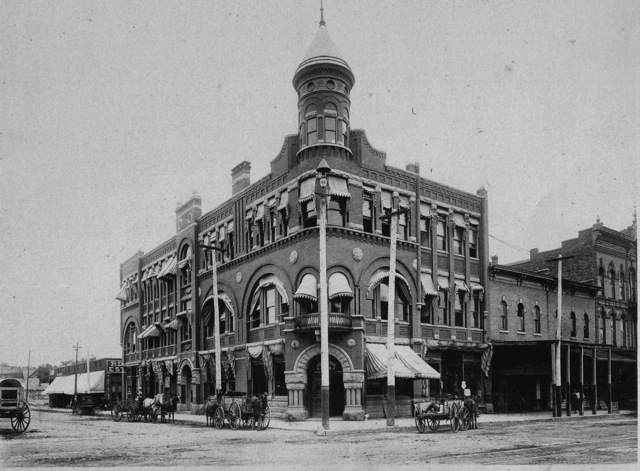
231 West Main Street at corner of Rusk Avenue
Built in 1891 as home of the
First National Bank.
Also called Ford Building, after the bank president at
the time of construction.
Later, sometime after 1912, the building housed
the Citizens National Bank.
Source of photo: "Art Work of Grayson County"
(1895), fig. 11.1.
That year the First National Bank constructed a fine
new edifice on its site. On June 21, 1891, the Sunday Gazetteer reported:
Another Rush Forward.
The First National Bank
Corner to be Torn Down and Rebuilt.
Arrangements are being made and work is soon to
begin in tearing down the two-story brick block at the corner of Main street
and Rusk avenue [231 West Main], preparatory to the erection of a handsome
three, probably four story stone and brick building. During the time required
in tearing down the old and putting up the new block, J. P. Marsh, the boot and
shoe man, will occupy the Harbison building, Lea's old stand, No. 324 Main
street, while the bank will go over to Woodard street and occupy quarters with
Messrs. J. J. Fairbanks & Co., in the post office building. On the
completion of the new house, both firms will return to their old stands.
Initially the new structure was referred to as the
First National Bank or Ford Building.
Meanwhile, another bank had been organized, confusingly
called The National Bank of Denison. The Sunday
Gazetteer of June 21, 1891, just cited, also informed its readers of plans
for this other bank to move into the Leeper & Boldrick Building (later
called Security Building), at the time approaching completion at 331 West Main
Street: 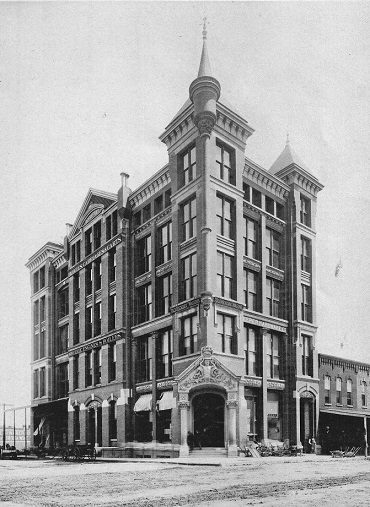
Leeper (Security) Building
331 West Main Street
Source: Art Work of Grayson County (1895 )
It was built in 1891 and was the tallest
building in North Texas.
After construction, this was initially
the home of the National Bank of Denison.
Monday morning next, Nov. 23, [1891,] The National
Bank of Denison will move from its old location at 124 Main street, to the new
Leeper & Boldrick building, corner Main street and Burnett avenue [331 West
Main]. The removal has been in contemplation five or six months, but the delay
has been occasioned from the unfinished condition of the building and the time
necessarily consumed by the factory in the completion of the banking furniture
and fixtures. At last, however, the room is finished, and, as stated, the bank
will take possession to-morrow.
The history of The National Bank of Denison is of
such recent date that it is not now necessary to enter an extended review, yet
as its removal to the new room is not only an event with the bank itself, but
an event in the financial history of the city, an extended notice of the
occurrence is not only altogether appropriate but a duty of the local press.
Not long after the sale of the State National by J.
N. Johnson to Mr. R. S. Shearman and associates, Mr. N. S. Ernst, who had been
connected with that institution for a period of six or seven years, retired,
and through his personal invitation induced Mr. C. S. Cobb, of Michigan, to
come to Denison and look over the field with a view to opening a new bank. The
matter was carefully weighed for several months, and pending the decision of
Mr. Cobb, the City Bank of Sherman opened a branch here. On the determination of
Mr. Cobb to come to Denison, negotiations looking to the purchase of the
Denison branch were opened with the directory of the Sherman City Bank, and
soon thereafter the announcement was given to the public that the sale had been
consummated. The transfer of the property was duly made, and on the change the
bank took the name of The National Bank of Denison, with C. S. Cobb, president;
N. S. Ernst, cashier; and R. S. Legate, teller; no change being made in the
location.
Early this year the corner room on the first floor
of the Leeper-Boldrick building was leased for a period of years and
immediately preparation began, looking to the removal of the bank to that room.
While the work has apparently progressed slowly, it has been as rapid as its
character would admit of. Western people are not, as a rule, familiar with the
unavoidable delay incident to the perfection of high art in design and
architecture, and a period of six months required in finishing and furnishing a
business room is considered a very long time. However, the work is finished,
and while there is no exaggeration or coarseness of profile in moldings, no
excess of ornament, there is everywhere a certain modesty, not unmixed with
refinement and elegance.
Opening to the southwest, the main entrance is on
the angle of Main street and Burnett avenue. Massive granite steps lead up from
the sidewalk to the vestibule, and on either side is a massive, highly polished
marble pillar, fourteen feet high and on which are capitals of stone with
handsomely carved designs. The enormous double doors are of solid walnut and
plate glass and have an emery and varnish finish.
Opening the door, the scene presented is that of a
model, modern banking house, entirely worthy of a city the size of St. Louis or
Kansas City, yet not one whit too good for Denison. The lobby has a floor of
white marble laid in squares. To the left are two handsomely finished full
mahogany desks for checks and drafts, for the use of customers. In front and to
the right are the offices of the institution. First, that of the cashier;
following this, that of the teller, then the book-keeper; and further down are
those of the collector, assistant teller, president, and last, the parlor or
ante-room designed for the use of the directors and the transaction of private
business. The furniture and fixtures, including the chairs and all the desks,
are of solid mahogany, with designs in hand-carving that are both beautiful and
appropriate, giving to everything a finished appearance, as well as lending to
the entire room an air of solidity and permanency that is truly refreshing.
The plan of the offices is that of a stairway, each
window being in full view of the main entrance. The bank counters separating
lobby from offices is formed of mahogany panels mounted on marble baseboards
with electro-bronze brass ornaments. The windows are all of electro-bronze brass
in beautiful designs. A heavy mahogany door leads into the cashier's room and
another of the same design and material leads from this room into that occupied
by the bank's clerical force.
The fire-proof vault stands in the rear center, and
its dimension on the outside is 12 x 18 feet; on the interior, 6 x 12. Leading
into the vault is a vestibuled iron and steel doorway, and on the inside is a
new burglar-proof steel safe with time attachments and of Hall's latest and
most improved make. In the vault are also stands and shelving for the books and
valuable papers of the institution. To the rear of the vault is a private
toilet room with water closet attachments.
The parlor, or directors' room, is finished in the
same plain yet elegant and massive style. The president's office presents a
rather frugal appearance. A linoleum flooring, two great easy chairs, and a
desk is all. Except the lobby and the president's room, the floor is covered
with a rich Brussels carpet.
A minute inspection of the finish of the room
proper, together with all the furniture and fixtures, fails to reveal traces of
careless workmanship, yet there is nothing whatever suggestive of show or
ostentation. The management of the bank desired to provide its customers and
employees a pleasant, elegant and permanent place in which to do business, not
only for the present but for years to come. To C. S. Cobb and N. S. Ernst,
Denison is due a debt of appreciation for the handsomest banking room in Texas,
not excepting the big institutions that are the pride of the Island City and
those of the city at the forks of the Trinity.
Around 1890, then, Charles Simeon Cobb moved to
Denison from Michigan to become president of the National Bank of Denison.
The 1891 City Directory listed four banks. Among
these were the State National with R.
C. Shearman as president, and the First
National Bank at 231 West Main under Ford. The City Bank of Denison (presumably the branch of the Sherman City
Bank discussed above), at 124 West Main, had Edward Perry as manager; A. H.
Coffin as vice-president; R. S. Legate, cashier; and P. J. Brennan, teller. Brennan
had arrived in Denison from Canada on June 7, 1890. The City Bank officially
consolidated with the National Bank of Denison on October 20, 1890. The recently
created National Bank of Denison had Cobb
as president; D. Osborn Fisher, vice-president; and N. S. Ernst, cashier. It is
useful to compare the capitalization of these banks:
·
City Bank of Denison: Authorized capital, $500,000; paid-up capital,
$400,000; surplus and undivided profits, $45,000.
·
National Bank of Denison: Capital stock, $200,000.
·
First National Bank: Paid-up capital, $150,000; surplus and undivided
profits, $25,000.
·
State National Bank: Paid-up capital, $150,000; surplus fund, $20,000.
The big Leeper-Boldrick Building was completed in
1891, and it is likely that the National Bank of Denison moved into its new
quarters as planned. But important changes occurred soon after that. It seems
clear that, following the completion of both the Leeper & Boldrick and the
Ford/National Bank buildings, the National Bank of Denison and the First
National Bank merged, and the new bank's offices were located in the National
Bank's building at 231 West Main. 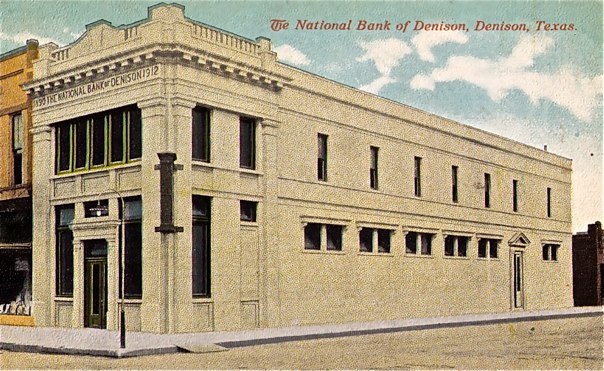
230 West Main Street
National Bank of Denison. Postcard.
The facade of this structure was reconstructed in its present gray granite Classical Revival
style in 1912, when the National Bank of Denison moved into this building.
In 1928, the bank vacated this structure and merged with the State National Bank across the street.
Later this building became the Bear Drug, with professional offices upstairs.
Today it is Phil Shaffer's law office.
Thanks to Carol Shaffer for the information.
The 1896 Denison City Directory lists only two
banks: the State National and the "First National Bank of Denison."
The new bank's officers were C. S. Cobb, president; D. O. Fisher, vice-president;
N. S. Ernst, cashier; and R. S. Legate, assistant cashier. Directors were D. O.
Fisher, J. M. Ford, E. H. Hanna, J. B. McDougall, C. S. Cobb, L. Eppstein, E.
A. Slack, J. D. Quinn, W. B. Munson, R. S. Legate, and W. H. Cobb. Capital was
$200,000; surplus, $15,000. The First National was located at the corner of
West Main Street and North Rusk Avenue. 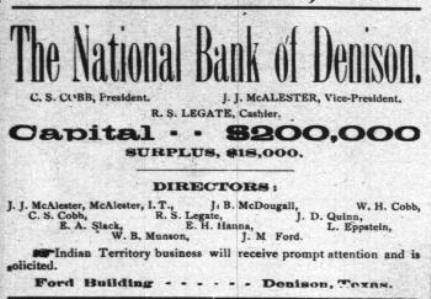 The Sunday Gazetteer
The Sunday Gazetteer
Sunday, December 11, 1898
pg. 3The 1901 City Directory showed only a few changes.
J. J. McAlester had replaced D. O. Fisher as bank vice-president, and Legate
had replaced Ernst as cashier. The directors were Cobb, McAlester, Legate,
Munson, McDougall, E. H. Hanna, G. C. Hanna, C. C. Jinks, J. R. Cullinane, and
E. A. Slack.
Around 1909, C. S. Cobb seems to have begun
disengaging from Denison. Somewhere along the line, the bank dropped "first"
from its name. 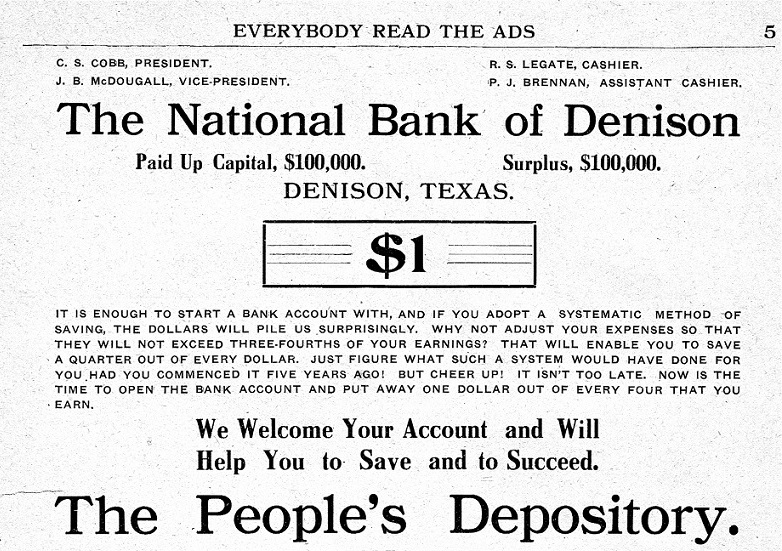
Ad, National Bank of Denison
Yellow Jacket, Xmas 1910
In 1912, the "National Bank of Denison" moved across
the street to 230 West Main, undertaking a major transformation of the former
James Boyd Clothing Store. Lettering at the top of the facade still reads
"The National Bank of Denison, 1882–1912." In 1913, the City
Directory listed Cobb as chairman of the bank's board, Legate as president,
Brennan as cashier, and T. F. Rogers and an aging J. B. McDougall as
vice-presidents. 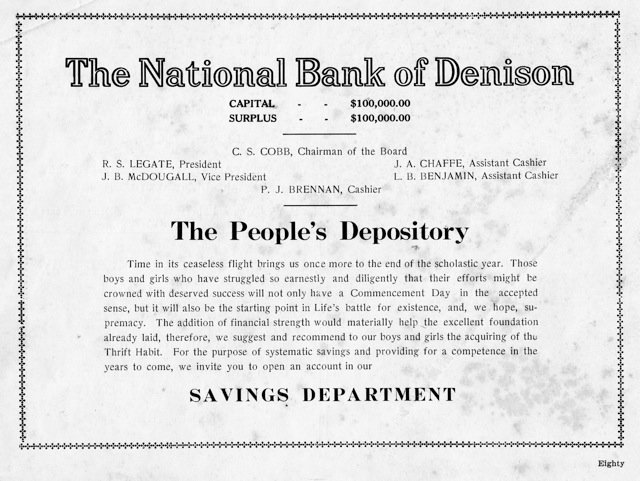
National Bank of Denison, advertisement
Yellow Jacket
1916
DHS
Yearbook, page 80
R. S. Legate died in 1920 and Brennan early in 1925.
Cobb seems not to have been involved in Denison after 1920, living in St. Louis
and traveling abroad. Finally, in 1928, the National Bank of Denison vacated its
building and merged with the State National Bank, located across Rusk Avenue at
300 West Main Street. The State National's president, G. L. Blackford, had
passed away in 1927. In 1929, the State National Bank officers were: Andrew Fox
Platter, chairman of the board; W. L. Peterson, president; J. W. Madden,
vice-president; T. F. Foley, cashier; Leo Murphy and E. L. Hopkins, assistant
cashiers.
|